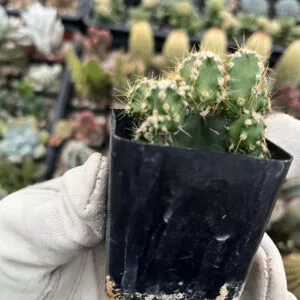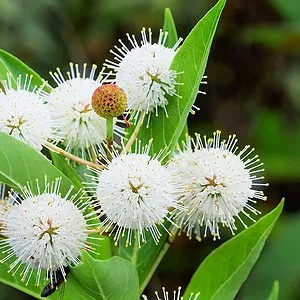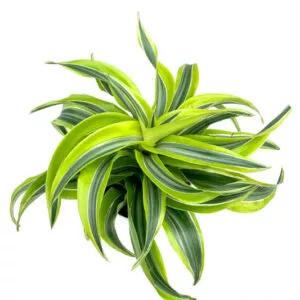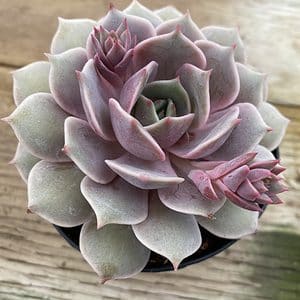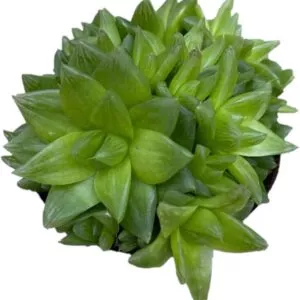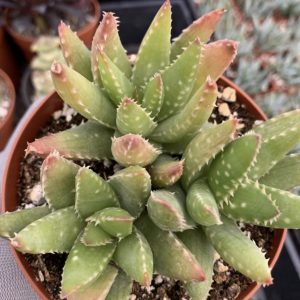No products in the cart.
Sweet potatoes are a delightful root vegetable that adds flavor to savory dishes and beautifies your garden with lush vines and orange flesh. It also has loads of health benefits. Whether you are planning to plant sweet potatoes in a garden bed or a half whiskey barrel, this guide will walk you through the steps to grow sweet potatoes successfully.
We’ve got you covered, from selecting the right variety to harvesting sweet potatoes.
Growing Sweet Potatoes Guide Table
Plant Name: Ipomoea batatas
Other Name: Sweet Potatoes
Plant Type: Perennial vine
Native Areas: South America
Light Requirement: Full sun
Watering: Deep watering, let the soil dry between watering
Fertilizer: Balanced fertilizer, avoid excess nitrogen
Toxicity: Leaves and vines can be toxic to animals
Temperature: Tolerant to heat but sensitive to cold weather
Propagation: Sweet potato slips or vine cuttings
Soil Type: Well-drained soil
USDA Hardiness Zones: Zones 9-11
Sweet Potato Gardening Tips
Understanding your USDA Hardiness Zone is crucial for growing sweet potatoes. Sweet potatoes thrive in Zones 9-11, which offer the warm temperatures and long growing season that these heat-tolerant plants require.
Plant sweet potatoes or slips in warm soil: Ensure the soil temperature has warmed to at least 60°F (15°C) before planting. This warmth encourages quick root development.
Space sweet potato plants 12-18 inches apart: Proper spacing allows each plant ample room to spread its lush vines and develop tubers without competition.
Planting depth: Place sweet potato slips or rooted sweet potatoes about 3-5 inches deep in well-draining soil.
Deep watering: Provide consistent moisture to these edible plants once a week. This ensures the plants’ root receives adequate hydration without waterlogging the soil.
Well-drained soil: Sweet potatoes grow best in well-drained loamy soil. Avoid heavy clay soils that can retain too much moisture.
Mulch: To retain soil moisture and suppress weeds, mulch heavily around the plants with organic matter.
Full sun: Sweet potatoes require at least 6-8 hours of full sun daily to thrive. Ensure they are planted in a location with ample sunlight throughout the day.
Heat Tolerance: These plants are highly tolerant to heat but sensitive to cold weather. Plant them after the last spring frost and harvest before the fall frost sets in.
Balanced fertilizer: Use a balanced fertilizer with a higher potassium content to encourage tuber development. Avoid excess nitrogen, which can promote excessive vine growth at the expense of tubers.
Useful insects: Invite beneficial insects like ladybugs and lacewings to your garden to naturally control pest populations and promote a healthy growing environment.
Sweet Potato Vines Care
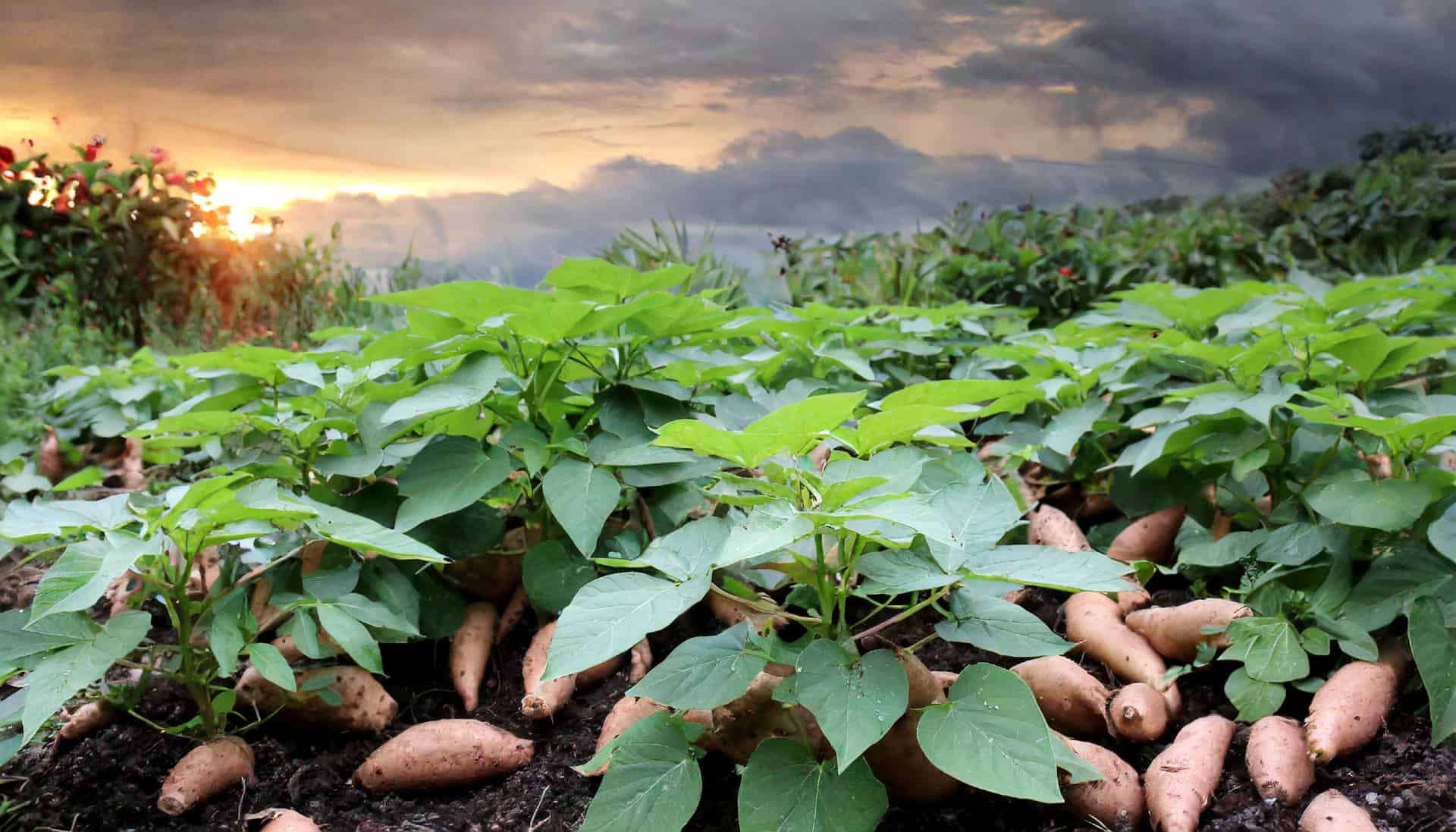
Navigating the care of sweet potatoes can seem like a complex task, but with the right guidance, you’ll find it surprisingly straightforward. Proper care ensures these vibrant root vegetables thrive, offering a bountiful harvest of nutritious tubers.
Soil and Water
In the world of soil and water management for sweet potatoes, the foundation lies in well-draining soil. This soil structure allows optimal root development, ensuring the tubers grow fully.
Yet, striking a balance in moisture levels is crucial; the soil should be kept consistently moist but never waterlogged, as excessive moisture can lead to stem rot and other fungal diseases.
To maintain this delicate balance, it’s advisable to adopt a deep watering regimen, providing a thorough soak once a week. This approach encourages the roots to delve deep into the soil in search of water, fostering a robust root system.
Additionally, allowing the soil to dry out slightly between watering cycles helps prevent issues like root rot. To further enhance moisture retention and suppress weed growth, mulch around the sweet potato plants.
It provides an extra protective layer and acts as a buffer against fluctuations in soil temperature, creating a more stable and conducive environment for sweet potatoes to grow.
Hot Tip🔥: While sandy soil or loamy soil can be suitable for growing sweet potatoes, it requires careful management and amendments to address specific characteristics and ensure optimal growing conditions for these root vegetables.
-
$15.00Sold By: Gardengineering
$20.00In stock
Brazil Philodendron
Only 1 available and it’s in 1 people’s basketRated 4.96 out of 5 based on 24 customer ratings00Sold By: Gardengineering -
$10.95Sold By: SunSoul Plants
$13.95In stock
Purple Waffle Plant, Hemigraphis alternata – Potted in a 3″ or 4″ pot with soil
Only 1 available and it’s in 3 people’s basketRated 4.87 out of 5 based on 98 customer ratings03Sold By: SunSoul Plants -
$17.95Sold By: SunSoul Plants
$22.95In stock
LIVE Ficus Altissima ‘Yellow Gem’ in 4″ pot
Rated 4.87 out of 5 based on 98 customer ratings05Sold By: SunSoul Plants -
$4.99Sold By: Cacti and Exotica
In stock
Cereus | Fairy castle cactus | 2″ Pot
Rated 4.98 out of 5 based on 59 customer ratings00Sold By: Cacti and Exotica
Light
Regarding light requirements for sweet potatoes, these tropical plants prefer full sun. It means they thrive when basking in at least 6-8 hours of sunlight daily.
Adequate sunlight is instrumental in fueling the process of photosynthesis, which in turn promotes healthy foliage growth and robust tuber development. Providing shade from intense afternoon sun is beneficial for plants in warm regions.

Strategically placing heat-tolerant plants to receive morning sun and afternoon shade optimizes their growing conditions and productivity. This light management approach ensures a generous harvest of sweet potatoes.
Temperature and Humidity
Navigating the complexities of temperature and humidity is important when cultivating sweet potatoes, especially considering their tropical origins.
These plants flourish in warm climates, making them well-suited for USDA Hardiness Zones 9-11. Ideal temperature ranges for sweet potatoes typically fall between 75°F and 95°F (24°C to 35°C) during the day, with slightly cooler temperatures at night.
While they revel in warm weather, it’s essential to be mindful of potential temperature extremes. Sweet potatoes are sensitive to cold and can be damaged by frost. Therefore, it’s crucial to time your planting to align with the last spring frost and ensure a bountiful harvest before the fall frost arrives.
Sweet potatoes thrive in humid environments and maintaining the right temperature and humidity levels is crucial for their growth and development. Proper care can lead to a bountiful harvest of flavorful sweet potatoes with leafy vines.
Fertilizer
Understanding the role of fertilizer is paramount in achieving a plentiful harvest of sweet potatoes. When selecting a fertilizer, choose a balanced formula with a higher potassium content, such as a 5-10-10 NPK ratio. Fertilizer once a month for matured plants.
Potassium is important for sweet potato growth and yield. Apply slow-release fertilizer at planting for a steady nutrient supply.
As the plants mature, consider side-dressing with a nitrogen-rich fertilizer, but exercise caution to avoid excessive nitrogen, which can stimulate excessive vine growth at the expense of tuber development.
Furthermore, incorporating compost into the soil can enhance its fertility and structure, creating a more hospitable environment for growing sweet potatoes.
Regular soil testing can provide insights into nutrient levels, enabling you to fine-tune your fertilization practices for optimal results.
Propagation
Sweet potatoes can be propagated from slips or vine cuttings. To grow your slips, place a whole sweet potato in a half whiskey barrel filled with potting mix. Shoots will emerge in a few weeks, which can be separated and planted in the garden bed.
Here is a Step-by-Step Guide for Propagating Sweet Potatoes:
Step 1: Selecting the Parent Plant
Choose a healthy sweet potato with desirable characteristics for a great harvest. Ensure that the sweet potato is free from damage or signs of disease.
Step 2: Preparing the Parent Plant
Place the selected sweet potato in a warm spot to encourage the growth of sweet potato slips. This process can take a few weeks, so be patient and monitor the sweet potato for signs of sprouting.
Step 3: Harvesting Sweet Potato Slips
Once the sweet potato has produced several slips, carefully remove them from the parent plant. Each slip should have its undamaged roots and a portion of the white skin from the sweet potato.
Step 4: Preparing the Planting Site
Choose a planting site in USDA Hardiness Zones 9-11 that receives full sun. Prepare the soil by ensuring it is well-drained and rich in organic matter. Consider using a whiskey barrel or raised beds if you have limited space.
Step 5: Planting the Slips
Plant the sweet potato slips in the prepared soil, spacing them 12-18 inches apart. Ensure that the soil line matches the soil level they were previously growing. This helps to prevent rot and promotes healthy tuberous root development. Also, avoid deep digging as it can damage the roots and lead to many undersized tubers.
-
$12.95Sold By: SunSoul Plants
$15.95In stock
Sansevieria Trifasciata snake plant in 3 or 4 inch pot
Rated 4.87 out of 5 based on 98 customer ratings00Sold By: SunSoul Plants -
Free Shipping$32.96 – $48.96Sold By: CZ Grain
In stock
Button Bush Seedlings to Plant
Rated 4.60 out of 5 based on 156 customer ratings00Sold By: CZ Grain -
$9.95Sold By: CTS Air Plants
In stock
Dracaena Lemon Surprise Houseplants
Only 20 available and it’s in 1 people’s basketSold By: CTS Air Plants -
Free Shipping$20.00Sold By: Bay Urban Habitat
In stock
Begonia Medora Angelwing | rooted plant
Sold By: Bay Urban Habitat
Step 6: Watering and Fertilizing
Water the newly planted slips thoroughly, ensuring the soil remains moist but not soggy. Incorporate a balanced fertilizer with a higher potassium content to support tuber development.
Step 7: Mulching and Weed Control
Mulch heavily around the sweet potato plants to retain soil moisture and suppress weeds. This also helps maintain a stable temperature, creating an optimal environment for sweet potatoes.
Step 8: Monitoring and Care
Regularly monitor the sweet potato plants for signs of pests or diseases, such as sweet potato weevils or rot. Address any issues promptly to prevent them from affecting the overall health of the plants.
Sweet Potato Varieties
Besides the regular potato, a world of sweet potatoes reveals a diverse array of varieties, each with its unique attributes and characteristics.
Beauregard: Known for its orange flesh and high yield, Beauregard is a popular choice among home gardeners and commercial growers alike.
Georgia Jet: This variety is prized for its early maturity and heat-tolerant nature, making it well-suited for warmer climates in USDA Hardiness Zones 9-11.
Purple Skin: As the name suggests, this variety stands out for its vibrant purple skin, adding a colorful touch to your garden and plate.
Bush Porto Rico: Recognized for its compact growth habit, Bunch Porto Rico is ideal for small gardens or containers like whiskey barrels. It also has a reddish-orange flesh.
Okinawan: Originating from Japan, this variety features unique purple flesh rich in antioxidants, offering visual appeal and nutritional benefits.
Vardaman: Developed for its disease resistance and abundant harvest, Vardaman is a reliable choice for ensuring a bountiful crop.
Centennial: With a balanced flavor profile and good storage capabilities, Centennial is a versatile variety suitable for various culinary applications, from savory dishes to desserts.
Nancy Hall: This heirloom variety boasts a rich history and is cherished for its exceptional flavor and texture, making it a favorite among sweet potato aficionados.
Each sweet potato variety offers unique characteristics in terms of flavor, texture, and appearance. Whether you’re looking to grow sweet potatoes for their deep orange flesh, vibrant purple skin, or exceptional flavor, there’s a variety suited to your preferences and growing conditions.
Sweet Potatoes Common Pests & Diseases and Troubleshooting

Growing sweet potatoes can be a rewarding experience, but like any crop, they are susceptible to certain pests and diseases. Luckily, they have very few pests that will bother your sweet potato patch.
Common Pests
Sweet Potato Weevils: These are perhaps the most notorious pests affecting sweet potatoes. Look out for wilting sweet potato vines and irregularly shaped holes in the tubers. Use row covers and rotate crops to manage infestations.
Aphids: These tiny insects can cluster on the undersides of leaves, causing them to turn yellow and distort. Regularly inspect your plants and use insecticidal soap or neem oil to control aphid populations.
Whiteflies: These pests can cause leaves to turn yellow and may transmit diseases. Introduce natural predators like ladybugs or use yellow sticky traps to monitor and control whitefly populations.
Common Diseases
Stem Rot: This fungal disease can cause the stems of sweet potato plants to rot at the soil line. Ensure good drainage and avoid overwatering to prevent stem rot.
Fusarium Wilt: This soil-borne disease can cause wilting and yellowing of the leaves. Plant disease-resistant varieties and practice crop rotation to minimize the risk of fusarium wilt.
Root Knot Nematodes: These microscopic pests can cause swellings or galls on sweet potato roots, affecting their growth. Rotate crops and use nematode-resistant varieties to manage this issue.
Troubleshooting Tips
Monitor Regularly: Inspect your sweet potato plants for signs of pests or diseases. Early detection can make management much more manageable.
Cultural Practices: Implement good cultural practices, such as proper spacing of plants, adequate watering, and timely harvesting, to reduce plant stress and minimize susceptibility to pests and diseases.
Natural Predators: Encourage natural predators like beneficial insects and birds to help control pest populations. Planting companion plants that attract helpful insects can also be beneficial.
How to Harvest Sweet Potatoes and Store Them

Harvesting sweet potatoes culminates your gardening efforts, but proper handling and storage are equally crucial to enjoying your homegrown bounty for an extended period.
When to Harvest
Timing: Sweet potatoes are typically ready for harvest 90-120 days after planting, depending on the variety and growing conditions. Look for signs such as yellowing foliage and a mature appearance of the tubers.
Weather Considerations: Aim to harvest sweet potatoes before the first fall frost, as frigid weather can damage the tubers.
How to Harvest Sweet Potatoes
Gentle Handling: Use a garden fork or spade to loosen the soil around the plants carefully. Avoid piercing or bruising the tubers, as this can affect their storability.
Manual Inspection: Gently lift the tubers from the soil by hand, examining each one for damage or signs of disease. Remove any damaged tubers from the harvest and remove excess dirt.
Curing: After harvesting, allow the sweet potatoes to cure in a warm, humid location for 10-14 days. This process enhances their sweetness and toughens the skin for better storage.
How to Cure Sweet Potatoes
Optimal Conditions: Store cured sweet potatoes in a cool, dry place with good ventilation. Ideal storage temperatures range from 55°F to 60°F (13°C to 15°C) with a relative humidity of 75-80%.
Avoid Refrigeration: Unlike regular potatoes, sweet potatoes should not be stored in the refrigerator, as cold temperatures can negatively impact flavor and texture.
Inspect Regularly: Periodically check stored sweet potatoes for any signs of sprouting, mold, or decay. Remove any compromised tubers to prevent spoilage.
Long-Term Storage: For long-term storage, consider preserving sweet potatoes by canning, freezing, or dehydrating them. These methods can extend the shelf life of sweet potatoes and provide a convenient supply for future use.
Frequently Asked Questions
Sweet potatoes should be planted in late spring after the last spring frost has passed, and the soil has warmed up.
Yes, you can grow sweet potatoes from a sweet potato. Place a whole sweet potato in a whiskey barrel cut in half filled with potting medium, and shoots will emerge in a few weeks.
On average, you can expect to harvest 3-6 sweet potatoes from one plant, depending on the variety and growing conditions.
Sweet potatoes thrive when planted alongside beans, corn, and morning glory. These companion plants help to improve soil fertility and deter pests.
Whether you want to buy, sell, or reach out to other plant enthusiasts, Plantly is the right place to be!
-
$20.00Sold By: Gardengineering
$25.00In stock
Scindapsus Pictus Exotica | Philodendron Silver | Satin Pothos
Rated 4.96 out of 5 based on 24 customer ratings00Sold By: Gardengineering -
$24.99Sold By: Succulent Oasis
$30.00In stock
Medium Succulent Plant ‘Angel Kissed’.
Rated 4.84 out of 5 based on 352 customer ratings00Sold By: Succulent Oasis -
$12.00Sold By: Beauties & Beasts
In stock
Succulent -Haworthiopsis cymbiformis
Rated 4.83 out of 5 based on 24 customer ratings00Sold By: Beauties & Beasts -
$14.00Sold By: Cacti and Exotica
In stock
Aloe Crosby
Rated 4.98 out of 5 based on 59 customer ratings00Sold By: Cacti and Exotica



